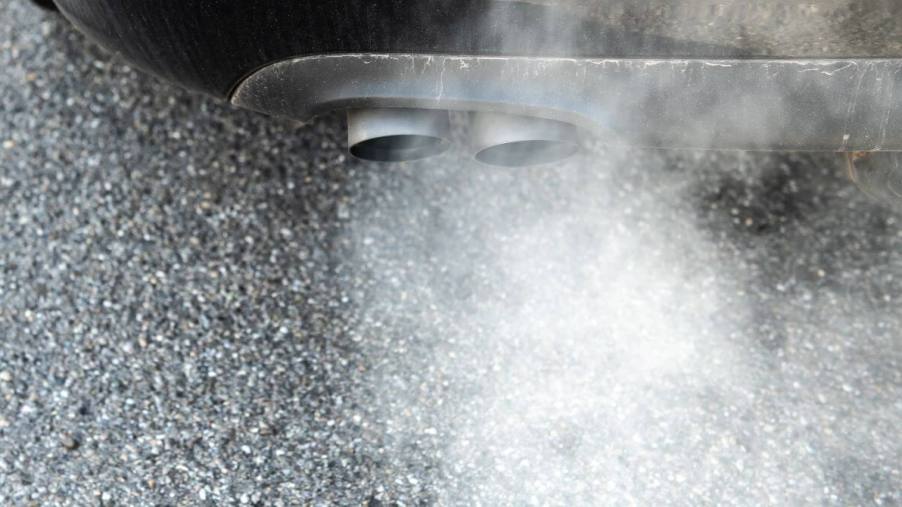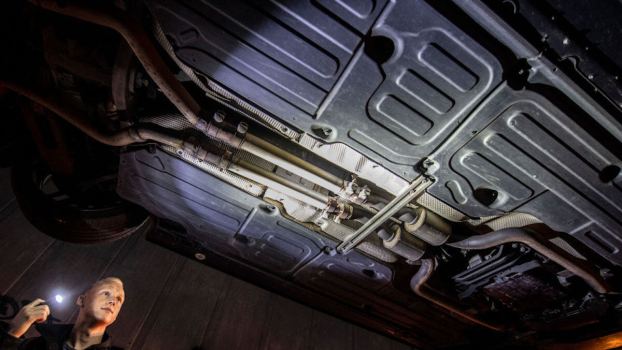
What Does White Smoke From a Car’s Exhaust System Mean?
Every gas-burning car makes power in the same way. As an air and fuel mixture enters an engine’s cylinders, that air and fuel are compressed by a piston and ignited by a spark plug. This combustion creates power that your transmission sends to the wheels. After combustion occurs in an engine, emissions are sent out of the exhaust pipe. These emissions are normal, and with the help of a catalytic converter, vehicles hardly produce any visible smog at all from the tailpipe.
However, occasionally, you might notice white smoke coming from your vehicle’s exhaust system. When does white smoke indicate a maintenance issue, and when should you worry? Here is everything you need to know about your vehicle’s exhaust system and why your car might be producing white smoke.
What is an exhaust system made out of?
A vehicle’s exhaust system consists of several important parts that allow your engine to get rid of the byproducts of the combustion process. According to Minit-Tune, the first part of this system is the exhaust manifold. This section of your exhaust system connects directly to the engine and sends gasses down the exhaust pipes. The next part of the system is the catalytic converter. Catalytic converters are very expensive components that consist of precious metals such as palladium, rhodium, and platinum. These metals cause a chemical reaction that removes nearly 90% of all toxins in the gasses that pass through.
These gasses then move through a muffler, which acts as a sound-deadening system. These mufflers keep your engine noise low. Finally, gases exit through the tailpipes, where they are expelled into the atmosphere.
Why is there white smoke in your vehicle’s exhaust?
According to MotorTrend, there are quite a few reasons why white smoke might be puffing out of your tailpipe. First, the most common white smoke you might see is light or thin white exhaust smoke. This is due to condensation that collects in your exhaust system as your vehicle rests. Some engines might also have a puff of smoke on startup due to oil flowing past piston rings and leaking into the cylinder. This initial puff of smoke could be this excess oil burning off. In extremely cold weather, it is also common to see a good amount of consumption in your exhaust as your car heats up.
However, not every puff of white smoke is normal. If your vehicle is emitting white smoke out of the exhaust system and it is hanging in the air, you may have a symptom of a blown head gasket. This white smoke is steam from the leaking head gasket, mixing oil and water, or coolant, into the combustion chamber. As this water or coolant gets in the way of the combustion process, it turns into steam as it exits your tailpipe. A blown head gasket is a major repair that requires a complete engine teardown. If you feel a loss of power, smell the sweet scent of burning coolant, or notice a ton of steam emitting from your tailpipe, immediately see a mechanic.
Are there other types of smoke that an engine can produce?
While white smoke can create the biggest cause for concern, other colors of smoke can be seen leaving a vehicle’s tailpipe. One of the most common types of smoke that you can see exiting a vehicle’s exhaust system is grey or blue smoke. This smoke indicates that oil is being burned somewhere in the car. According to AutoExpress, worn valve seals, worn piston rings, and failing turbochargers could be the culprit.
Every so often, you may also see black smoke from the exhaust. This black smoke is typically only seen in older vehicles with old exhaust systems. Typically, black smoke is due to a buildup of soot in the exhaust system after years and years of service.
Your vehicle can emit a few different types of emissions, but if you ever notice any unusual smoke leaving your vehicle’s exhaust system, make sure you get it evaluated sooner rather than later!




